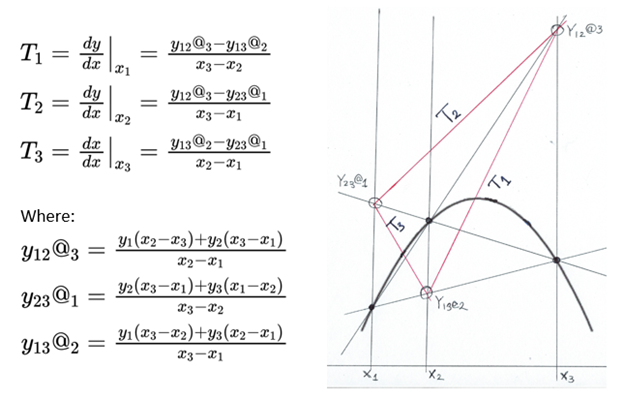This paper presents a detailed demonstration of the exact nature of Aitken’s construction for generating points on a parabola.
It also introduces the FLINE, a function for generating points on a line, providing a direct way to encode Aitken’s construction.
It will be shown that points on a parabola generated by Aitken’s construction are identical to the points generated by a second order Lagrange polynomial.
Additional work shows how to construct tangents on the Parabola.
Please note: MathPix, GreenShot, Notepad++ proved to be extremely helpful in composing this paper.
Aitken, A. (1932). On Interpolation by Iteration of Proportional Parts, without the Use of Differences.
Proceedings of the Edinburgh Mathematical Society, 3(1), 56-76. doi:10.1017/S0013091500013808
Introducing FLINE to evaluate points on the line defined by end points (X1, Y1) and (X2, Y2),

it is then easy to encode Aitken’s Construction

Expanding and collecting like terms:


reproduces the second order Lagrange polynomial.

A Side note:
Generating a point using Lagrange polynomial requires 3 divisions, 15 multiplications, 6 subtractions and 3 additions.
On the other hand, Aitken formulation only requires 3 divisions, 6 multiplications, 9 subtractions and 3 additions.
Extension of the Construction to Evaluate the Tangents at Defining Points of the Parabola
Using FLINE as a point of focus. Further examination of the Aitken Construction led to the realization that local tangents to the parabola could also be constructed.
The development of the construction will begin with the polynomial. Taking the first derivative of Lagrange Polynomial

and evaluating it at a particular point say (X2, Y2)


Continuing:


The Tangent at point (X2, Y2) can then be express in terms of FLINE



Continuing, all three tangents can then be evaluated

It should be noted that:

Showing how the tangent can be computed from the secants.

I have always coded the equivalent of FLINE as a two-line function:
t = (x-x1)/(x2-x1)
y = t*y2 + (1-t)*y1
because my usual application was to insert several equally spaced points on the line between two given points, either in a plane or in space. Sometimes not equally spaced. fline(x1,y1, x2,y2, t) usually 0<t<1
No matter how you slice or dice it, it looks like one addition, 3 subtractions, 2 multiplications and one division.
If you are coding in Fortran, you should declare FLINE to be a PURE ELEMENTAL FUNCTION. Then, if x is a scalar, FLINE returns a scalar; but,if x is a vector, it returns a vector of the same size as x.
LikeLiked by 1 person
In my day of FORTRAN IV – I declared it as a statement function.
LikeLike